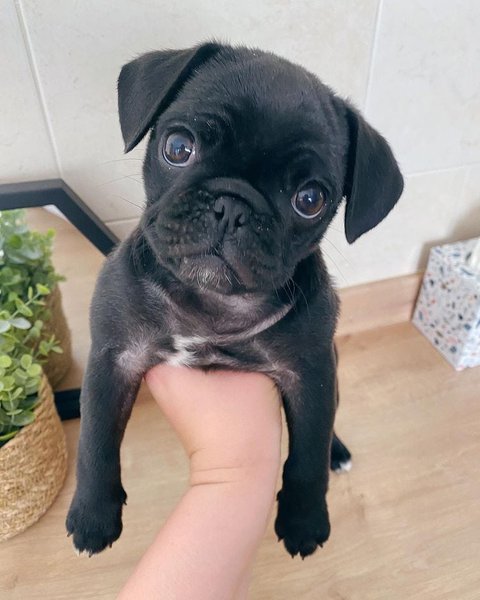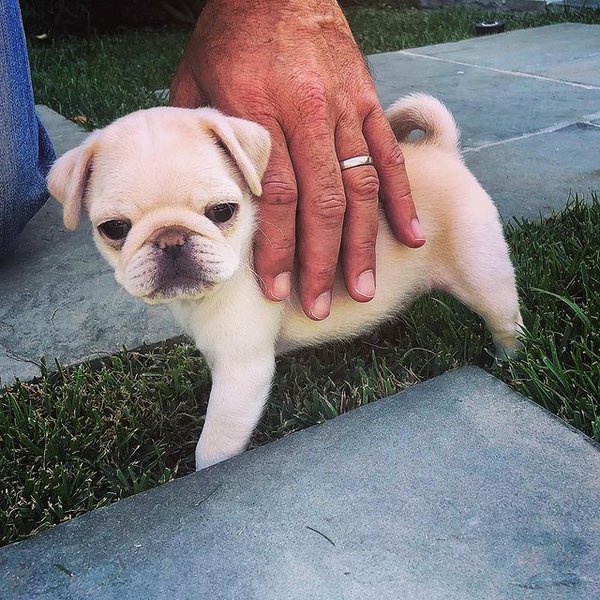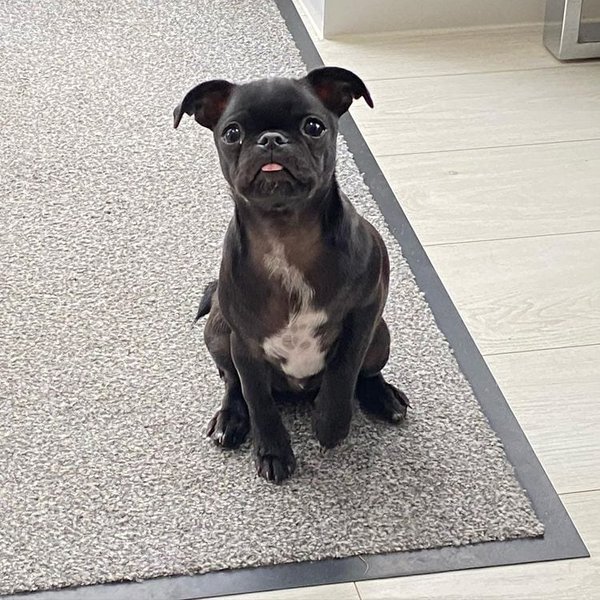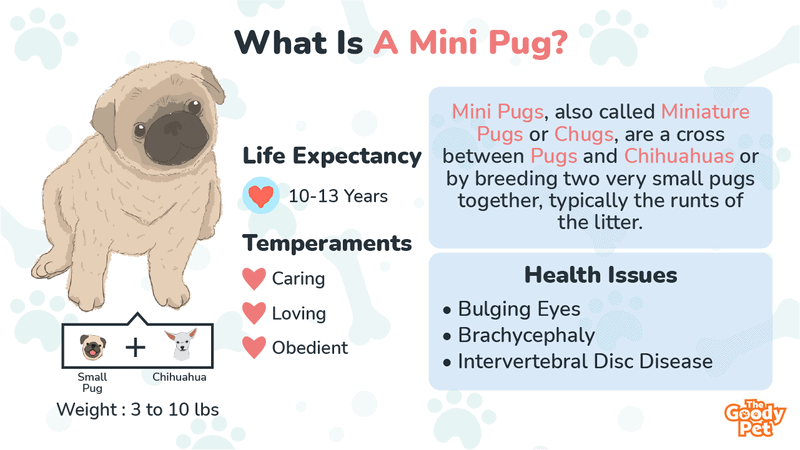Pugs are among the most easily recognized dog breeds, but have you ever seen a pug that just seems too small? These are mini pugs.
Mini pugs, also called miniature pugs or chugs, are a cross between pugs and Chihuahuas or by breeding two very small pugs together, typically the runts of the litter. The first method is preferred, as serious health problems can come from breeding two runts.
This does not mean that mini pugs are free from health problems. We take a look at the temperament, lifespan, and health issues associated with mini pugs as well as how they compare to teacup pugs. But first, let us explore the basics of this breed, from their size to what makes them special.
Is There A Mini Pug?

There are several methods of breeding of mini pugs, including mixes and miniature pugs, but people commonly call all types miniature pugs or mini pugs.
The mixes come from pug and Chihuahua parents. Miniature pugs come from the runts of a pug litter or from introducing a dwarfism or achondroplasia gene.
Mini pugs that have Chihuahua and pug parents are also called Chugs, Chuggs, and Pughuahuas. This is the most accepted definition of mini pugs. You may hear them called “hybrid” or “designer” dogs. Those bred from runts are commonly called “pocket pugs.”
According to the American Kennel Club, mini pugs are not a separate breed. The AKC recognizes miniature pugs as a type of pug. Importantly, this designation does not apply to the mixes that come from breeding a pug with a Chihuahua.
How Big Do Mini Pugs Get?
When full-grown, mini pugs typically weigh 3 to 10 pounds.
By contrast, full-size pugs typically weigh 14 to 18 pounds.
Like full-sized pugs, mini pugs have large round heads with wrinkled brows and large, dark eyes. They have smooth coats that are short and require minimal grooming.
Mini pugs, like pugs, are brachycephalic.
This type of breed has deep facial folds and a face that is short and flat. Pugs of all sizes are usually all black or have a black face on apricot-fawn or silver coloring.
Miniature pugs share their history with their full-sized counterparts that they were bred from. Pugs have been around since at least 400 B.C. They are associated with Buddhist monks and Chinese emperors.
Teacup Pug VS Miniature Pug

Is a teacup pug real? Yes, but the teacup pug is not an officially recognized independent breed.
Because neither mini pugs nor teacup pugs are recognized AKC breeds, the terms are sometimes used interchangeably. Both describe pugs that are smaller than average, typically around 3 pounds.
Although naming conventions vary, the most common depends on the breeding history of the pup. A miniature pug is a cross between a pug and a Chihuahua. A teacup pug is the result of breeding two runts or pugs with dwarfism.
The name “teacup pug” comes from the fact that these pooches are small enough to fit in a teacup.
Based on those naming conventions, miniature pugs have slightly longer snouts than teacup pugs. This comes from their Chihuahua genes.
Visually, teacup pugs look just like pugs but much smaller. Miniature pugs, on the other hand, will have some obvious features of Chihuahuas, like that previously mentioned slightly larger snout. Put simply, they will not look purebred.
While mini pugs are usually 3 to 10 pounds when fully grown, teacup pugs are usually 2 to 5 pounds.
Mini pugs usually live 10 to 13 years, but teacup pugs have a life expectancy closer to 6 to 10 years.
Both mini pugs and teacup pugs are closely related to full-sized pugs but very small. Their small size leads to similar health problems and concerns, from difficulties with birth to overcrowded mouths.
How Long Does Mini Pugs Live? Common Health Problems Of A Mini Pug
We mentioned that breeding two runts together can be problematic. The issue is that runts tend to not meet the breed standard. As such, they have a higher risk of heart defects, hypoglycemia, and other health issues.
Intervertebral Disc Disease
If you were to instead use the dwarfism gene, the mini pug would have a high risk of intervertebral disc disease, known as IVDD. This is a degenerative condition typically related to age, but it can occur in younger dogs in the case of mini pugs. It occurs when the discs degenerate due to their loss of ability to ‘hold water.’
Brachycephaly
The biggest health concern for mini pugs is the brachycephaly that also gives them their unique face shape.
This syndrome is not good for a canine’s respiratory system. The short snout blocks their air passage, this increasing the risk of respiratory problems.
It also makes it harder for a mini pug to regulate his body temperature. As such, if you get a mini pug, you need to avoid long walks in hot weather and always ensure your pug gets enough water.
The airway problems also make it harder for pugs to recover after exercise. But you cannot skip walking your pug, since he needs exercise.
Bulging Eyes
The large eyes of mini pugs pose their own problems too. There is a higher risk of scratches due to their size and they can be prone to corneal ulcers, a problem inherited from Chihuahuas.
Deformed Bone Structure
The screw tails of pugs are cute but occur due to misshapen bones. This can be painful for pugs and lead to neurological problems, like incontinence or even paralysis.
Dental Problems
Since mini pugs have small mouths, their teeth crowd close to each other. This increases the risk of gum disease and tooth decay. Crowded teeth make it easier for food to get caught between them and harder to get them clean. This leads to more tooth decay, and eventual periodontal disease.
Others
Other potential mini pug health concerns include myelopathy, dystocia (problems giving birth), and epileptic seizures.
How To Take Care Of A Mini Pug?
Healthy Diet
Start by giving your mini pug a healthy diet that caters to his needs. Make sure to feed it only the essential nutrients and no filler ingredients that are commonly found among cheap dog food brands. Don’t skimp and save on their diet.
Some of caring for a mini pug comes down to being aware of his potential health problems. For example, if you take your miniature pug for a walk, you need to bring water so he doesn’t overheat.
Warmth
In the winter, you will need to prevent your pooch from getting cold, as he has less body heat. Always invest in clothing for cold weather and rain gear.
Dental Hygiene
You also need to stay on top of brushing your pug’s teeth to reduce the risk of tooth decay or gum disease. You will need to pay close attention to get all of their crowded mouth to avoid plaque buildup.
Careful Handling
You also need to take extra care because of your furry friend’s small size. Tiny dogs that weigh as little as three pounds require delicate handling, especially when they are still growing. You need to place them down gently, pay attention to not stepping on them and generally treat them delicately.
Be cautious at all times. When you drive with a mini pug, make sure he is secured so he doesn’t fall off the seat if you stop suddenly. In your home, make sure you always pay attention to where the pug is when walking.
Even a child stepping on a miniature pug could cause serious damage. Their small size also means you should avoid having your mini pug sleep in your bed. Not only could you roll onto it, but they may suffocate under your blankets.
Mini pugs may also take longer to potty train since their bladders are smaller.
Temperament Of A Mini Pug
Historically, people bred pugs as companions for royals. The mini pug temperament remains the same today, making them a great house dog. In fact, thanks to their royal breeding, some people compare the demeanor of mini pugs to that of humans.
Mini pugs, like full-sized pugs, tend to be shadows that follow their human everywhere. Mini pugs are obedient, caring, and loving.
Your miniature pug will get along well with your family. It will also be friendly towards other people. Mini pugs even do well with babies, cats, and other dogs.
Like their larger cousins, mini pugs prefer not to be left alone.

Its size and temperament are what make the mini pug a good choice for those who live in small spaces, including in urban areas.
They also do very well in the country with plenty of space to explore as well. Just don’t expect them to walk too far, due to reasons between their size and their breathing problems.
You should be aware that mini pugs can be strong-minded.
This makes them a bit harder to train if you lack patience. With patience, however, they will be well-behaved. Pugs want to make their humans happy, so rely on positive reinforcement.
You should also know that mini pugs tend to bark more than other breeds. Because of this, you should start training your canine not to bark as much early on.
Related Questions
Are Mini Pugs Hypoallergenic? No, the AKC does not classify mini pugs as hypoallergenic. You can, however, reduce the risk of an allergic reaction by staying on top of your pug’s grooming routine. Brush him weekly, outside your home and bathe him every three months.
What Is The Smallest Pug Breed? Teacup pugs are the smallest pug breed. They weigh just two to five pounds and many can easily fit in a teacup. Because teacup pugs are small, they require extra caution as they can get injured easily.
How Much Do Mini Pugs Cost? The price depends on where you get the pooch. Because of the health concerns of mini pugs, always be sure to buy from a reputable breeder that makes the health of the canines a priority.





